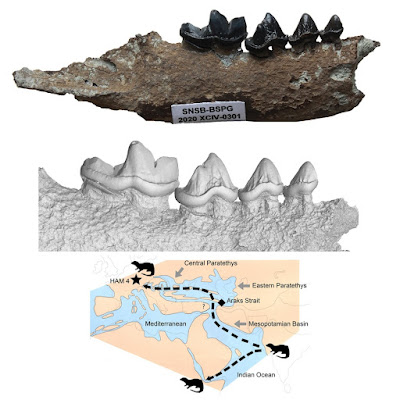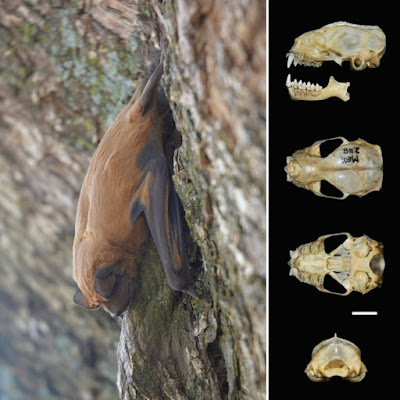[Most Recent Entries] [Calendar View]
Thursday, September 23rd, 2021
| Time | Event | ||||
| 2:00a | [PaleoMammalogy • 2021] Vishnuonyx neptuni • A New early late Miocene Species of Vishnuonyx (Carnivora: Mustelidae: Lutrinae) from the Hominid Locality of Hammerschmiede, Bavaria, Germany
ABSTRACT This study presents a new species of a large-sized lutrine from the upper Miocene hominid locality of Hammerschmiede, Vishnuonyx neptuni sp. nov., reporting the first occurrence of the genus in Europe and its most northern and western record. The new species differs from the already known members of the genus in size (intermediate between the African Vishnuonyx? angololensis and the Asiatic Vishnuonyx chinjiensis) and morphology, in particular in the larger P4 hypocone, the primitive morphology of M1 (paraconule present, enlarged protoconule and metaconule, labial expansion at the paracone area), the shorter and more robust lower premolars and the wider m1 trigonid. We hypothesized that the dispersal event that led to the expansion of the genus in Europe seems to be correlated with the water connection between Paratethys and the Mesopotamian Basin during the Konkian, between 13.4 and 12.65 Ma. In terms of paleoecology, it is here suggested that this form was feeding mainly on fish and less on bivalves or plant material, resembling the extant giant otter, Pteronura brasiliensis. Vishnuonyx neptuni sp. nov. Nikolaos Kargopoulos, Alberto Valenciano, Panagiotis Kampouridis, Thomas Lechner and Madelaine Böhme. 2021. New early late Miocene Species of Vishnuonyx (Carnivora, Lutrinae) from the Hominid Locality of Hammerschmiede, Bavaria, Germany. Journal of Vertebrate Paleontology. e1948858. Researchers in Germany discover a new species of otter | ||||
| 2:11a | [Mammalogy • 2021] Molossus melini • A New Species of Molossus (Chiroptera: Molossidae) from Argentina, in the Pampa Ecoregion
Abstract Fourteen species of bats in the genus Molossus currently are recognized in the Neotropical region; only three are known from Argentina. Here, we describe a new species based on specimens collected in the province of Santa Fe, Argentina, in the Pampa ecoregion. The new species can be distinguished from its congeners by its general strong orange coloration, forearm length > 41 mm, dorsal hairs bicolor and long (~5 mm), infraorbital foramen laterally oriented, and long and forward-projected (pincer-like) upper incisors. The external and cranial morphology of the new species are described and comparisons made with other species of similar size and with those present in its distributional area. Wilcoxon tests and multivariate analyses (nonmetric multidimensional scaling ordination and PERMANOVA) were carried out to determine the morphometric differences between the new species and other seven species of Molossus. The species tree, estimated by *BEAST from the concatenation of mitochondrial and nuclear genes, suggests that Molossus sp. nov. is basal within the clade formed by {{M. aztecus, M. rufus}, {{M. currentium, M. pretiosus}, M. sinaloae}} with a posterior probability of 0.82. Keywords: Argentina, Molossus, new species, Pampa ecoregion, Santa Fe province
Family Molossidae Gervais, 1856 Genus Molossus É. Geoffroy St.-Hilaire, 1805 Molossus melini sp. nov. Etymology: The name melini is in reference to Cacique Melin, leader of “Los Ranqueles,” an indigenous tribe from the region, who was murdered on the shores of the Melincué lagoon (named for Melin and his son, Cue, also killed in the same battle), near the type locality of the species. Many local legends surround these indigenous people and the lagoon. M. Eugenia Montani, Ivanna H. Tomasco, Ignacio M. Barberis, Marcelo C. Romano, Rubén M. Barquez and M. Mónica Díaz. 2021. A New Species of Molossus (Chiroptera: Molossidae) from Argentina. Journal of Mammalogy. gyab078. DOI: 10.1093/jmammal/gyab078 Se reconocen actualmente 14 especies de Molossus en el Neotrópico, de las cuales tres están presentes en Argentina. Describimos en el presente trabajo una especie nueva de este género sobre la base de ejemplares procedentes de la ecorregión Pampeana de la provincia de Santa Fe, Argentina. La nueva especie se distingue de las otras especies de Molossus por su coloración general fuertemente anaranjada, longitud del antebrazo > 41 mm, pelos dorsales largos (~5 mm) y bicolores, foramen infraorbitario orientado lateralmente, e incisivos superiores largos y proyectados anteriormente como pinzas. Incluimos la descripción de la morfología externa y craneal de la nueva especie, comparando esta última con especies similares, así como con aquellas presentes en su área de distribución. Llevamos a cabo pruebas de Wilcoxon y análisis multivariados (NMDS y PERMANOVA) para determinar las diferencias morfométricas entre la nueva especie y otras siete especies de Molossus. El árbol de especies, estimado por *BEAST a partir de la concatenación de genes mitocondriales y nucleares, sugiere que Molossus sp. nov. se ubica, con una probabilidad posterior de 0.82, dentro del clado formado por {{M. aztecus, M. rufus}, {{M. currentium, M. pretiosus}, M. sinaloae}}. Argentina, Ecorregión Pampeana, Molossus, nueva especie, provincia de Santa Fe |
| << Previous Day |
2021/09/23 [Calendar] |
Next Day >> |







